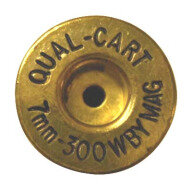7mmx300 Weatherby Magnum
This cartridge is a “wildcat,” in that it is a handloader's-only proposition. It is simply the 300 Weatherby Magnum necked down to 7mm, as far as the cartridge itself goes; but it is so much more. That all started back in October of 1970, when Mary Louise DeVito of Williamsport, Pennsylvania, used her unlimited-class benchrest rifle in 7mmx300 to set a new World’s Record. And when that record was finally toppled about four years later, it was Kenneth A. Keefer Jr, from New Columbia, Pennsylvania, who did it with his 7mmx300. Mary Louise had shot a 7-11/16ths-inch group, and Keefer Jr shot one that measured 6.125”. Now here’s the hard part… these were ten-shot groups fired at a scoring target; all of Keefer’s bullets were inside the 7-inch “10” Ring! Ten consecutive, unspotted, shots. Talk to me about accuracy.
I don’t know who came up with the idea of necking the 300 Weatherby down to 7mm, but Howard Wolfe of Mifflinburg, Pennsylvania built both of the rifles. Mary’s was on a FN 400 Benchrest Action, and Keefer’s was a Remington. Both used big, heavy, 1-1/4” untapered barrels of about 30" in length, and both used H-570 Powder. Both rifles also had a twist rate of one-in-nine inches, and both shooters used the Sierra 168-grain MatchKing Bullet (#1930).
Prior to this, a few shooters were having moderate success at 1000 yards using what was then known as the 6.5x300 WWH (Weatherby-Wright-Hoyer), a round that has recently been introduced by Weatherby as the 6.5-300 Weatherby Magnum. Lt. Colonel Paul Wright came up with the cartridge, and gunsmith Alex Hoyer built Wright the first rifle to use it. Incidentally, the use of a hyphen (-) instead of an (x) in the cartridge designations is mostly a matter of choice, but the hyphen seems to have gained preference in recent years.
Which of the two cartridges is best? Well, call it as you see it, but my solid opinion is that the 7mmx300 is significantly better than the big 6.5. Either of them will require more than a typical magnum-length barrel of 26 inches. A better place to start would be at 28 inches. And then, on a direct comparison — to have the same barrel volume for burning the slow powders required for decent performance — if a 7mmx300 barrel was 28 inches long, the 6.5 barrel would have to be roughly 32 inches long to provide that equal barrel volume! Said another way, the 6.5-300 Weatherby Magnum is pretty much an impractical proposition in a carry rifle.
At this time, a friend is working on a 7mmx300 Weatherby project. He has the very last stock that ever came out of E.C. Bishop & Son when they closed decades ago, which was a special order with enough beef to handle an unlimited-class rifle. Some projects take awhile.
It will be a barrel of at least 28 inches, and possibly a 9” twist, but more likely 8-1/2”. With either choice, it’s clear that he won’t be trying to use some of the extremely long bullets made today. The 175-grain Sierra MatchKing (#1975) is of particular interest, so an 8-1/2-inch twist would be the proper choice.
Dealing with my opinion again, I believe the 7mmx300 Weatherby is the best option in a very-large-capacity 7mm cartridge; better than the 7mm STW, 7mm Remington Ultra Magnum, 28 Nosler, and better than anything else that doesn’t have a wonderful belt and that efficiently smooth, header-like, double-radius shoulder. Cartridge cases are absolutely simple to make. A pass into a trim die and a few strokes with a smallish mill bastard file, and then an in-and-out trip through full-length sizer. Presto! What fun!
JDC
